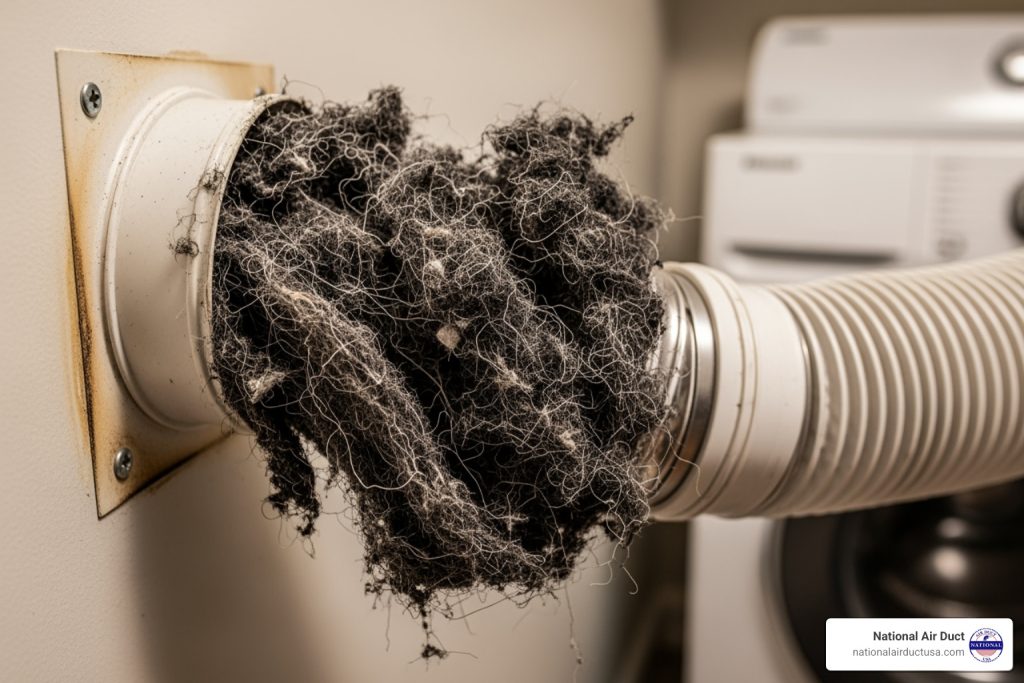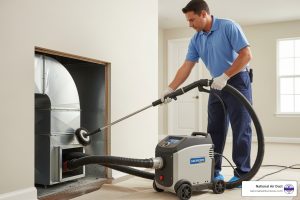Why Your Dryer Vent Needs Immediate Attention
A clogged dryer vent is one of the most dangerous yet overlooked fire hazards in any home. While it seems harmless, the lint that accumulates in your dryer’s ductwork is highly flammable. Most homeowners don’t realize that this innocent-looking buildup is a ticking time bomb, creating the perfect conditions for a devastating fire. Each load of laundry contributes more fuel, turning your ventilation system into a serious risk that causes thousands of house fires every year.
Quick Facts About Clogged Dryer Vents:
- Fire Risk: Approximately 15,970 home fires annually involve clothes dryers
- Primary Cause: 34% of dryer fires are caused by lint accumulation
- Cost Impact: $238 million in property damage yearly
- Warning Signs: Longer drying times, hot dryer exterior, burning smell
- Prevention: Annual professional cleaning is strongly recommended
There might be a hidden fire hazard lurking around your home and you don’t even know it. The worst part? You probably use this appliance multiple times a week without a second thought. It’s your clothes dryer.
The reality is stark: Fire departments respond to an average of 15,970 home structural fires each year involving clothes dryers, with 92% attributed to dryers specifically. Even more concerning, 27% of these fires are caused by dust and lint in the lint trap or dryer vent, a problem that is entirely avoidable.
But fire isn’t the only danger. A clogged dryer vent forces your appliance to work harder and run longer, dramatically increasing your energy bills. It can also cause carbon monoxide and other dangerous gases to back up into your home, especially with gas dryers, creating serious air quality risks for your family, pets, and loved ones. This can lead to headaches, dizziness, and other health issues that are often misattributed to other causes.
The good news? This is completely preventable. With the right knowledge and a proactive approach, you can eliminate this hidden danger, protect both your family and your wallet, and ensure your home remains a safe haven.
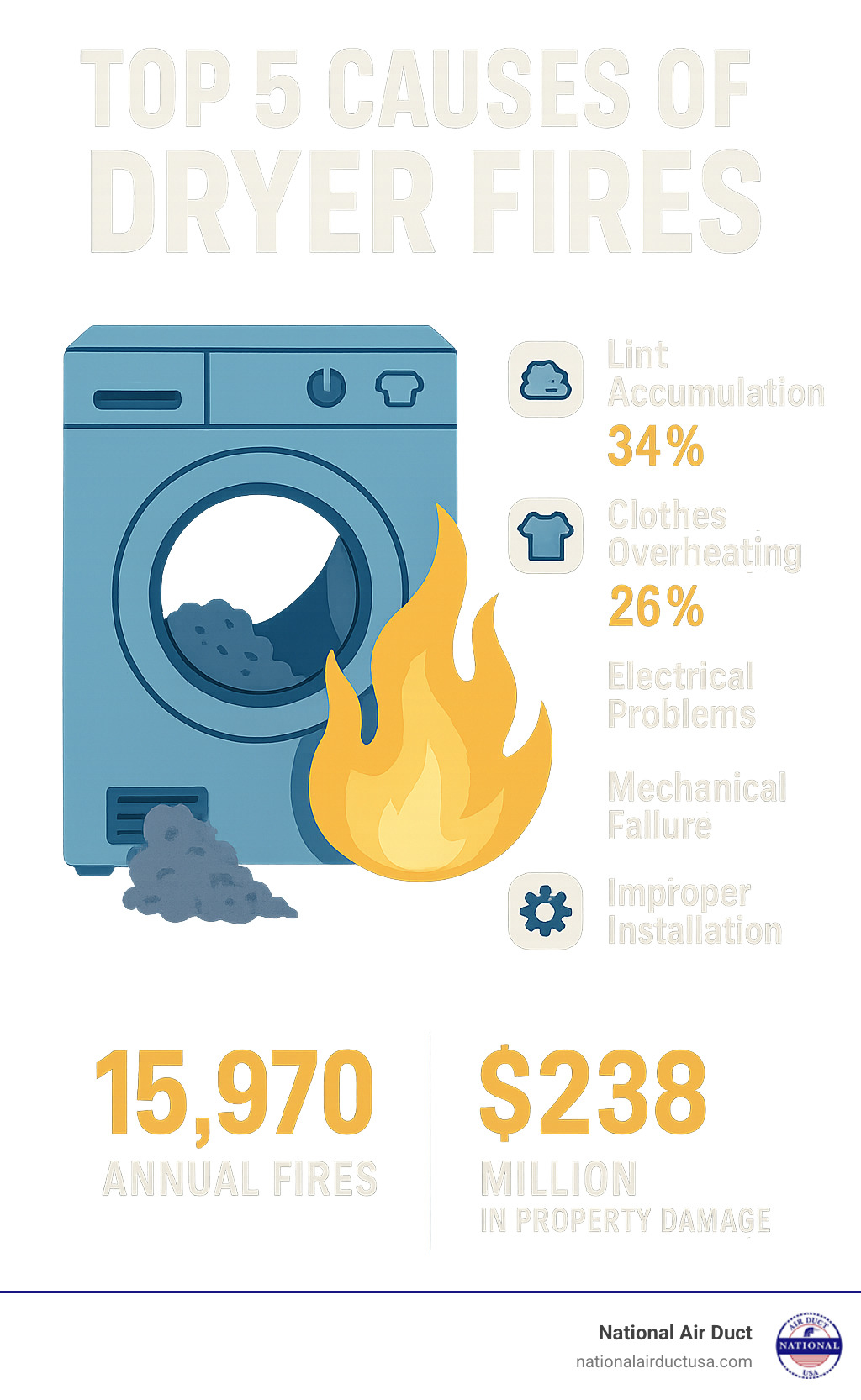
Why a Clogged Dryer Vent is a Hidden Danger in Your Home
That innocent‐looking lint buildup is one of the most common — and most overlooked — causes of house fires. When lint restricts airflow, your dryer overheats, creating a dangerously high temperature inside the duct. Add one spark from the appliance’s heating element or motor, and you have a ready-made tinder box. According to the National Fire Protection Agency (NFPA), failure to clean is the leading cause of home clothes dryer fires.
If you own a gas dryer, the danger doubles. A blocked vent doesn’t just pose a fire risk; it can force deadly, odorless carbon monoxide back into your laundry area and throughout your home.
Fire and CO aren’t the only problems. A clogged vent creates a cascade of other issues:
- Increased Energy Consumption: Your dryer has to run longer and work harder to dry your clothes, which directly translates to a spike in your monthly utility bills.
- Premature Appliance Failure: The extra strain wears out motors, belts, and heating elements, leading to costly repairs and shortening the lifespan of your dryer.
- Mold and Mildew Growth: A blocked vent traps hot, moist air inside the ductwork. This creates the perfect breeding ground for mold and mildew, which can then circulate into your home, affecting your indoor air quality and potentially causing allergic reactions.
- Pest Infestations: Birds, rodents, and insects are often attracted to the warm, sheltered space of an exterior dryer vent. They can build nests inside, completely blocking the vent and introducing other contaminants into your home.
The Alarming Statistics Behind Dryer Fires
- 15,970 home fires every year involve clothes dryers.
- $238 million in property damage annually.
- 34 % of those fires start with lint that should have been removed.
- A dryer-related fire ignites every 37 minutes in the U.S.
More Than Just a Fire Hazard
Beyond the immediate danger of fire, a blocked vent quietly drains your wallet and degrades your home’s environment:
- Higher energy bills from longer, inefficient cycles.
- A shorter dryer life span due to unnecessary wear and tear.
- Mold growth and poor IAQ from trapped moisture.
- A serious carbon-monoxide risk for homes with gas dryers.
Worried you already have an issue? Don’t wait for a warning sign to become an emergency. Schedule a professional Dryer Vent Inspection to get a clear picture of your system’s health.
Is Your Dryer Vent Clogged? 7 Telltale Signs to Watch For
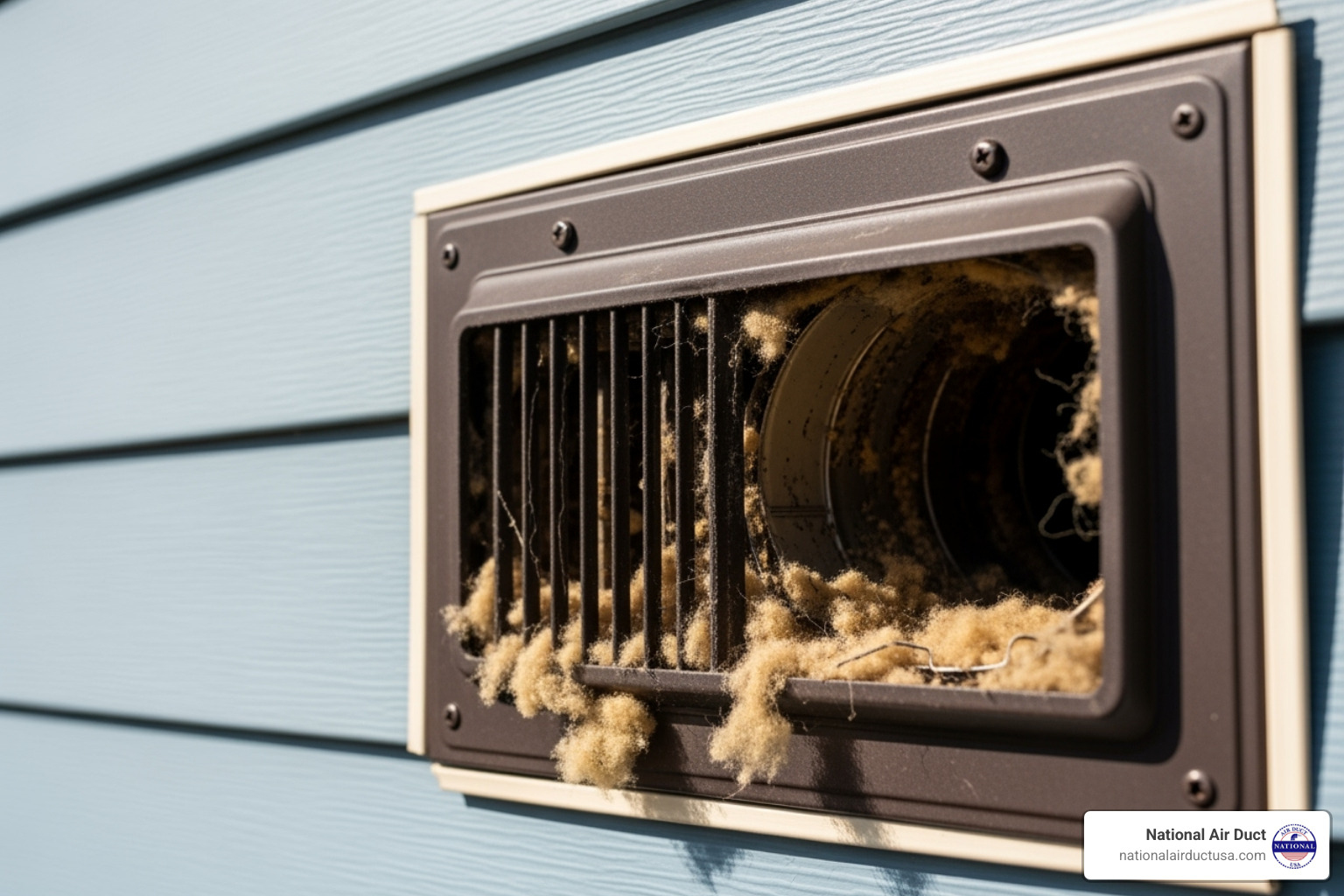
Your dryer will usually give you clear warning signs when the vent is becoming dangerously blocked. Pay close attention to these telltale indicators:
- Clothes take longer than one cycle to dry. If you find yourself running the dryer for a second or even third cycle, it’s a classic sign that trapped heat and moisture can’t escape.
- The top or back of the dryer feels excessively hot. A properly vented dryer expels heat outside. If the appliance itself is hot to the touch, it means heat is building up internally, which is a major fire risk.
- You notice a burning or musty smell. A burning smell indicates that lint trapped in the vent is getting hot enough to scorch. A musty odor suggests that moisture is trapped, leading to mold and mildew growth.
- Lint builds up around the dryer or the exterior vent. If you see lint collecting on the ground outside your vent or behind the dryer, it means the clog is so significant that air can no longer carry the lint away.
- Clothes come out damp or smell musty. Even after a full cycle, your clothes may feel damp or have a mildew-like smell because the moist air had nowhere to go.
- The laundry room feels unusually humid. A clogged vent will release hot, moist air back into the laundry room instead of venting it outdoors, creating a humid, uncomfortable environment.
- Little or no lint collects on the lint screen. This is a counterintuitive but critical sign. If your lint trap is empty after a load, it could mean the blockage in the duct is so severe that it’s preventing air from flowing through the trap to begin with.
What Causes a Clogged Dryer Vent?
- Gradual lint accumulation in long or complex duct runs.
- Too many sharp bends or kinks in the hose behind the dryer.
- Crushed or improperly installed flexible plastic/foil ducts, which trap lint easily.
- Exterior vent screens or flaps that are blocked or fail to open properly.
- Bird or rodent nests built inside uncovered exterior vents.
How Often Should You Clean?
- Most homes: once a year.
- Heavy use or large families: every 6 months.
- Pet owners or constant use: every 3 months.
Tie it to your seasonal home-maintenance checklist so it never slips your mind.
Your Step-by-Step Guide to Cleaning a Clogged Dryer Vent
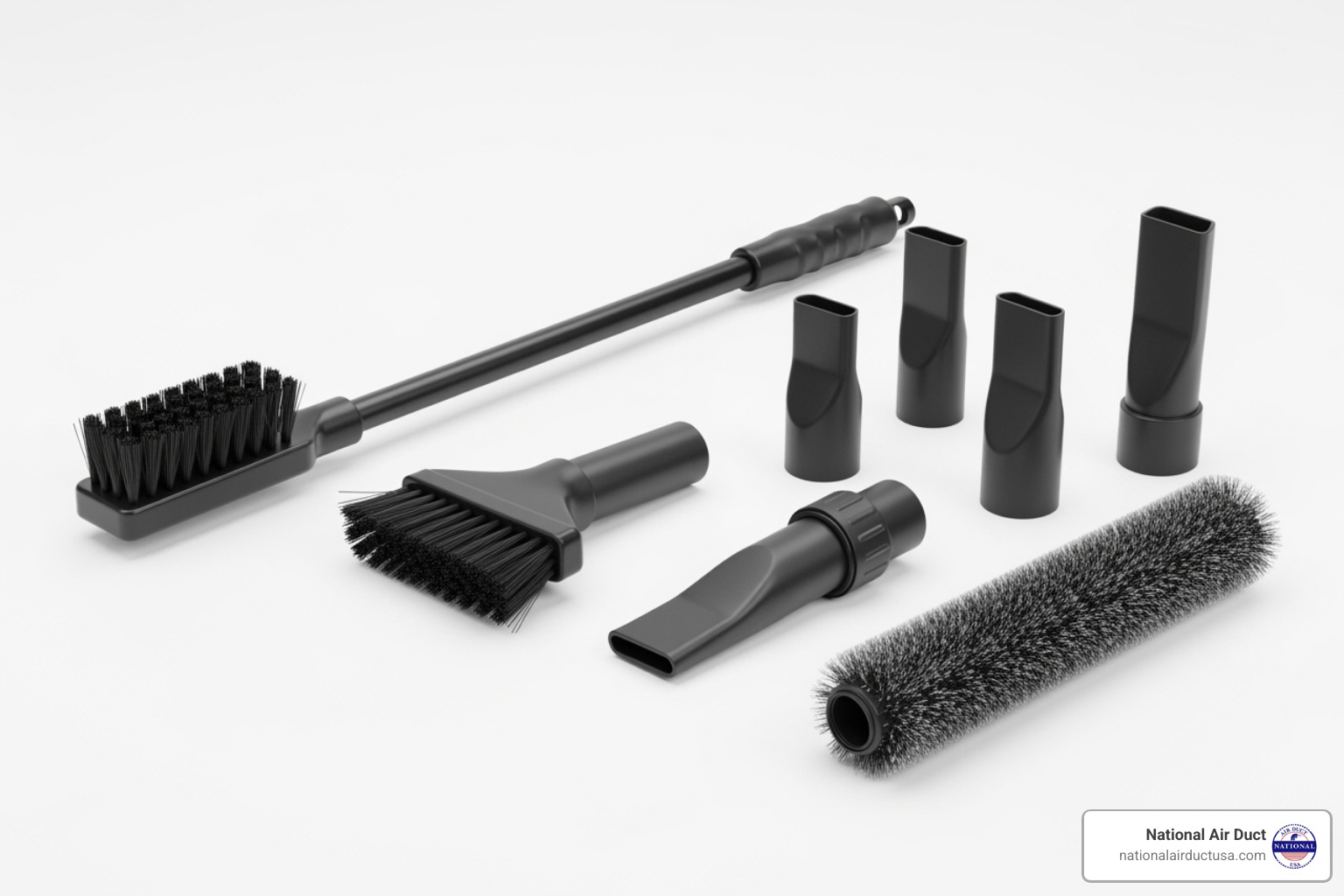
Prefer to DIY? Follow these streamlined steps, or skip the mess and book our Dryer Vent Cleaning service.
Safety First
Unplug the dryer, shut off the gas valve, and wear gloves, eye protection, and a dust mask.
Step 1 – Disconnect
- Pull the dryer away from the wall.
- Loosen the clamp and detach the vent hose.
- Place a trash bag under the connection to catch loose lint.
Step 2 – Clean
- Vacuum the dryer’s exhaust port and lint-trap cavity.
- Feed a dryer-vent brush into the duct, rotating to break up lint.
- Repeat from the exterior vent: remove the cover and brush toward the dryer.
- Vacuum any debris that falls out.
Step 3 – Reconnect & Test
- Inspect the duct; replace crushed or torn sections. If damage is extensive, see our Dryer Vent Repair options.
- Re-secure the hose with the clamp and seal joints with UL-listed metal foil tape.
- Slide the dryer back carefully—no kinks!
- Restore power/gas and run a 10-minute fluff cycle. Feel strong airflow outside? Job done.
Beyond DIY: When to Call a Professional
DIY kits work for short, straight runs. Call a pro when:
- The duct is longer than 15 ft or has multiple 90° turns.
- The vent exits through a roof or second story.
- You can’t reach blockages or suspect birds’ nests.
- You’ve cleaned recently but problems persist.
| DIY Kit | Professional Service | |
|---|---|---|
| Cost | $20-$30 | $100-$180 |
| Time | ≈1 hr | 1-2 hrs |
| Reach | Limited | Full-length, all turns |
| Tools | Basic brush & vacuum | High-powered vacuums, rotary brushes, cameras |
| Safety Guarantee | Depends on homeowner | NADCA-certified, insured |
Why Choose National Air Duct?
- NADCA-certified technicians follow DEDP standards.
- Powerful equipment removes compacted lint instead of just pushing it deeper.
- Written report and before/after photos for total peace of mind.
Learn more about our Residential Dryer Vent Cleaning.
Does Homeowners Insurance Cover Dryer Fires?
Most policies cover fire damage, additional living expenses, and liability. However, insurers may reduce payouts if negligence—such as ignoring a known blockage—is proven. Review your policy with your agent to be safe. Talk to your insurance agent to make sure you have the proper coverage.
Frequently Asked Questions about Dryer Vent Maintenance
How can I prevent lint buildup between cleanings?
- Empty the lint trap after every load.
- Don’t overload the dryer.
- Upgrade to rigid metal ductwork.
- Keep the exterior vent flap clear.
- Vacuum behind the dryer two or three times a year.
- Wash the lint screen with warm, soapy water quarterly to remove fabric-softener residue.
Can I use household items to clean my vent?
It’s risky. Regular vacuums and leaf blowers often compact lint farther down the line. Professional brush systems pull lint out instead of pushing it deeper. When in doubt, call a pro.
Clogged vent or broken dryer—how do I tell?
- Disconnect the vent hose.
- Run the dryer on air-only.
- Strong airflow + heat when disconnected = vent problem.
- No heat or weak airflow directly from the dryer = appliance issue.
If your ductwork is damaged beyond repair, explore our Dryer Vent Replacement services.
Protect Your Home and Family with a Clean Dryer Vent
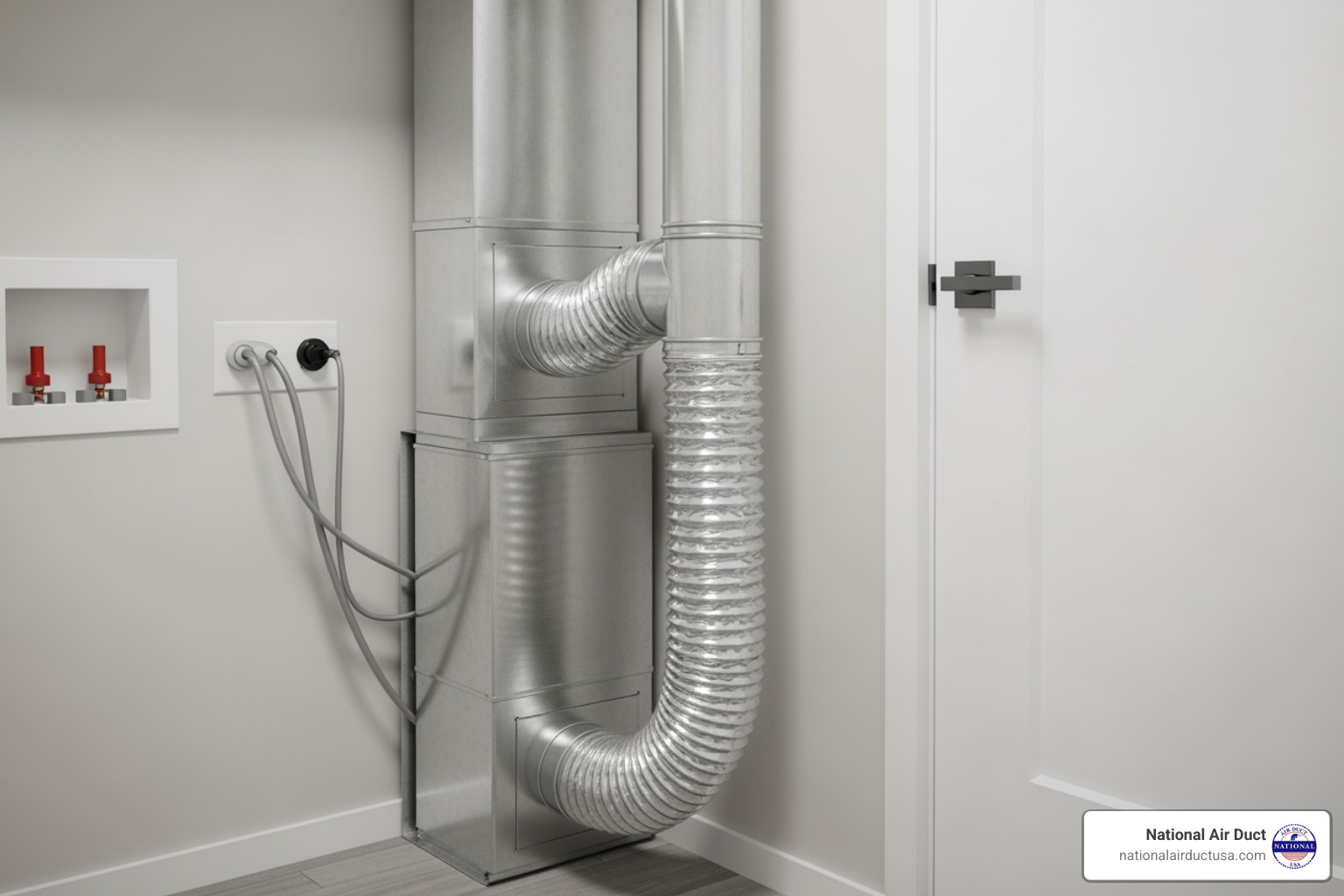
A clear vent means:
- Lower fire risk
- Faster drying times & smaller energy bills
- Longer appliance life
- Healthier indoor air
Put dryer-vent cleaning on your annual to-do list—or let the NADCA-certified team at National Air Duct handle it for you. We serve homeowners across New York from our Westbury headquarters, delivering affordable, same-day service when possible.
For worry-free safety and efficiency, book your appointment now: Schedule your professional cleaning service today

